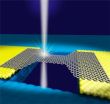(Press-News.org) CAMBRIDGE, MA -- When it comes to learning languages, adults and children have different strengths. Adults excel at absorbing the vocabulary needed to navigate a grocery store or order food in a restaurant, but children have an uncanny ability to pick up on subtle nuances of language that often elude adults. Within months of living in a foreign country, a young child may speak a second language like a native speaker.
Brain structure plays an important role in this "sensitive period" for learning language, which is believed to end around adolescence. The young brain is equipped with neural circuits that can analyze sounds and build a coherent set of rules for constructing words and sentences out of those sounds. Once these language structures are established, it's difficult to build another one for a new language.
In a new study, a team of neuroscientists and psychologists led by Amy Finn, a postdoc at MIT's McGovern Institute for Brain Research, has found evidence for another factor that contributes to adults' language difficulties: When learning certain elements of language, adults' more highly developed cognitive skills actually get in the way. The researchers discovered that the harder adults tried to learn an artificial language, the worse they were at deciphering the language's morphology — the structure and deployment of linguistic units such as root words, suffixes, and prefixes.
"We found that effort helps you in most situations, for things like figuring out what the units of language that you need to know are, and basic ordering of elements. But when trying to learn morphology, at least in this artificial language we created, it's actually worse when you try," Finn says.
Finn and colleagues from the University of California at Santa Barbara, Stanford University, and the University of British Columbia describe their findings in the July 21 issue of PLOS ONE. Carla Hudson Kam, an associate professor of linguistics at British Columbia, is the paper's senior author.
Too much brainpower
Linguists have known for decades that children are skilled at absorbing certain tricky elements of language, such as irregular past participles (examples of which, in English, include "gone" and "been") or complicated verb tenses like the subjunctive.
"Children will ultimately perform better than adults in terms of their command of the grammar and the structural components of language — some of the more idiosyncratic, difficult-to-articulate aspects of language that even most native speakers don't have conscious awareness of," Finn says.
In 1990, linguist Elissa Newport hypothesized that adults have trouble learning those nuances because they try to analyze too much information at once. Adults have a much more highly developed prefrontal cortex than children, and they tend to throw all of that brainpower at learning a second language. This high-powered processing may actually interfere with certain elements of learning language.
"It's an idea that's been around for a long time, but there hasn't been any data that experimentally show that it's true," Finn says.
Finn and her colleagues designed an experiment to test whether exerting more effort would help or hinder success. First, they created nine nonsense words, each with two syllables. Each word fell into one of three categories (A, B, and C), defined by the order of consonant and vowel sounds.
Study subjects listened to the artificial language for about 10 minutes. One group of subjects was told not to overanalyze what they heard, but not to tune it out either. To help them not overthink the language, they were given the option of completing a puzzle or coloring while they listened. The other group was told to try to identify the words they were hearing.
Each group heard the same recording, which was a series of three-word sequences — first a word from category A, then one from category B, then category C — with no pauses between words. Previous studies have shown that adults, babies, and even monkeys can parse this kind of information into word units, a task known as word segmentation.
Subjects from both groups were successful at word segmentation, although the group that tried harder performed a little better. Both groups also performed well in a task called word ordering, which required subjects to choose between a correct word sequence (ABC) and an incorrect sequence (such as ACB) of words they had previously heard.
The final test measured skill in identifying the language's morphology. The researchers played a three-word sequence that included a word the subjects had not heard before, but which fit into one of the three categories. When asked to judge whether this new word was in the correct location, the subjects who had been asked to pay closer attention to the original word stream performed much worse than those who had listened more passively.
Turning off effort
The findings support a theory of language acquisition that suggests that some parts of language are learned through procedural memory, while others are learned through declarative memory. Under this theory, declarative memory, which stores knowledge and facts, would be more useful for learning vocabulary and certain rules of grammar. Procedural memory, which guides tasks we perform without conscious awareness of how we learned them, would be more useful for learning subtle rules related to language morphology.
"It's likely to be the procedural memory system that's really important for learning these difficult morphological aspects of language. In fact, when you use the declarative memory system, it doesn't help you, it harms you," Finn says.
Still unresolved is the question of whether adults can overcome this language-learning obstacle. Finn says she does not have a good answer yet but she is now testing the effects of "turning off" the adult prefrontal cortex using a technique called transcranial magnetic stimulation. Other interventions she plans to study include distracting the prefrontal cortex by forcing it to perform other tasks while language is heard, and treating subjects with drugs that impair activity in that brain region.
INFORMATION:
The research was funded by the National Institute of Child Health and Human Development and the National Science Foundation.
Try, try again? Study says no
2014-07-21
ELSE PRESS RELEASES FROM THIS DATE:
Fires and Smoke in Canada's Northern Territories
2014-07-21
Environment Canada has issued a high health risk warning for Yellowknife and surrounding area because of heavy smoke in the region due to forest fires. Currently 160 wildfires are burning across the region. There are no plans for evacuation since these fires are endangering people or property. Weather that has been hitting the area recently comes with mixed results. The rains help to dampen the fires, but the lightning tends to start others.
This year the Northern Territories have seen 855,000 hectares (over 2,100,000 acres) burned as opposed to the territories 10 ...
Researchers provide guide to household water conservation
2014-07-21
BLOOMINGTON, Ind. -- Want to conserve water and save on your utility bill? A paper co-written by an Indiana University researcher and published in the current issue of the journal Environment can help.
"The Water Short List: The Most Effective Actions U.S. Households Can Take to Curb Water Use" describes how households can reduce water use substantially by simple actions such as installing more efficient appliances and changing day-to-day habits involving water consumption. While the suggestions may be familiar, the researchers are the first to put a comprehensive, quantitative ...
Penn study: Understanding graphene's electrical properties on an atomic level
2014-07-21
Graphene, a material that consists of a lattice of carbon atoms, one atom thick, is widely touted as being the most electrically conductive material ever studied. However, not all graphene is the same. With so few atoms comprising the entirety of the material, the arrangement of each one has an impact on its overall function.
Now, for the first time, researchers from the University of Pennsylvania have used a cutting-edge microscope to study the relationship between the atomic geometry of a ribbon of graphene and its electrical properties.
A deeper understanding of ...
Louisiana Tech University professor presents at International Bioprinting Congress
2014-07-21
RUSTON, La. – Dr. Mark DeCoster, the James E. Wyche III Endowed Professor in Biomedical Engineering at Louisiana Tech University, will present as an invited speaker at the International Bioprinting Congress, July 24-25 at the Biopolis Research and Development Center in Singapore.
DeCoster, who is also a research faculty member in Louisiana Tech's Institute for Micromanufacturing, will present a lecture titled, "Bioprinting interfaces for 2D and 3D cell and tissue models." The presentation will focus on the development of a novel, matrix-free method for generating 3D ...
UCI researchers find epigenetic tie to neuropsychiatric disorders
2014-07-21
Irvine, Calif., July 21, 2014 — Dysfunction in dopamine signaling profoundly changes the activity level of about 2,000 genes in the brain's prefrontal cortex and may be an underlying cause of certain complex neuropsychiatric disorders, such as schizophrenia, according to UC Irvine scientists.
This epigenetic alteration of gene activity in brain cells that receive this neurotransmitter showed for the first time that dopamine deficiencies can affect a variety of behavioral and physiological functions regulated in the prefrontal cortex.
The study, led by Emiliana Borrelli, ...
Transiting exoplanet with longest known year
2014-07-21
Astronomers have discovered a transiting exoplanet with the longest known year. Kepler-421b circles its star once every 704 days. In comparison, Mars orbits our Sun once every 780 days. Most of the 1,800-plus exoplanets discovered to date are much closer to their stars and have much shorter orbital periods.
"Finding Kepler-421b was a stroke of luck," says lead author David Kipping of the Harvard-Smithsonian Center for Astrophysics (CfA). "The farther a planet is from its star, the less likely it is to transit the star from Earth's point of view. It has to line up just ...
Communication about female condom vital to young adults, UT Arlington researchers say
2014-07-21
The female condom is one of just two barrier methods that can protect against sexually transmitted infections and unplanned pregnancies, yet many young adults are not aware of the device, a new study by two UT Arlington researchers has found.
They say the reason could lie in the way information about the female condom is communicated to young people.
Charla Markham Shaw, associate professor of communication, and Karishma Chatterjee, an assistant professor of communication studies in The University of Texas at Arlington College of Liberal Arts, co-authored the paper "Communicating ...
Parents rank their obese children as 'very healthy'
2014-07-21
A University of California, San Diego School of Medicine-led study suggests that parents of obese children often do not recognize the potentially serious health consequences of childhood weight gain or the importance of daily physical activity in helping their child reach a healthy weight.
The study is published online in the Journal of the Academy of Nutrition and Dietetics.
"Parents have a hard time changing their child's dietary and physical activity behaviors," said lead author Kyung Rhee, MD, and an assistant adjunct professor in the Department of Pediatrics. "Our ...
NASA satellite sees Typhoon Matmo brush eastern Philippines
2014-07-21
A NASA satellite captured an image of the western quadrant of Typhoon Matmo brushing over the eastern Philippines on July 20.
NASA's Terra satellite passed over Typhoon Matmo on July 20 at 02:15 UTC and the Moderate Resolution Imaging Spectroradiometer or MODIS instrument aboard captured a visible image of the storm. The MODIS image showed a thick band of thunderstorms west of the storm's center were sweeping over the eastern Philippines.
The Joint Typhoon Warning Center (JTWC) noted that animated multispectral satellite imagery on July 21 showed that convection (rising ...
Stem cells aid muscle repair and strengthening after resistance exercise
2014-07-21
CHAMPAIGN, Ill. — A new study in mice reveals that mesenchymal (mezz-EN-chem-uhl) stem cells (MSCs) help rejuvenate skeletal muscle after resistance exercise.
By injecting MSCs into mouse leg muscles prior to several bouts of eccentric exercise (similar to the lengthening contractions performed during resistance training in humans that result in mild muscle damage), researchers were able to increase the rate of repair and enhance the growth and strength of those muscles in the exercising mice.
The findings, described in the journal Medicine and Science in Sports and ...






